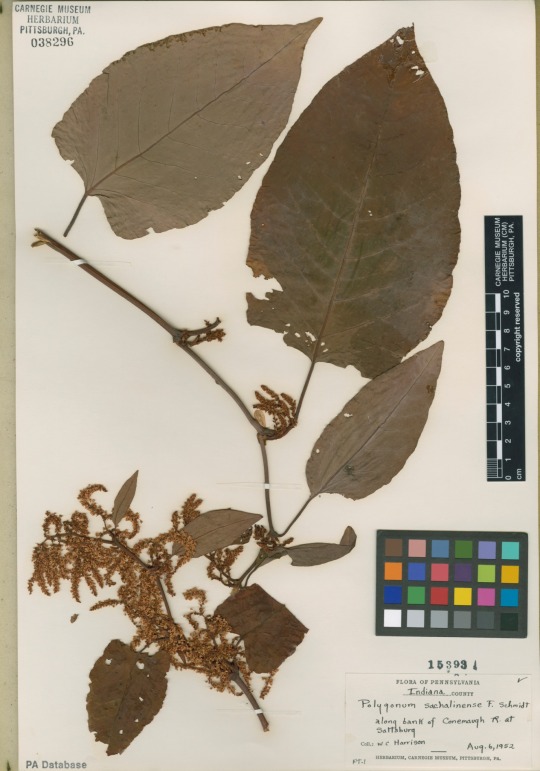by Mason Heberling

A few weekends ago, I went to the 7th annual Knotweed Festival in Blairsville, about 40 miles east of Pittsburgh in Indiana County. Aside from reading a brief advertisement, I knew little about the festival before going. But, given I study non-native plant invasions, I had to go to a celebration named after a local weed that is a focus of my research! And this invader is one of the most aggressive and widespread ones in western Pennsylvania – Japanese knotweed.
Native to East Asia, Japanese knotweed (Fallopia japonica) is a large herbaceous perennial that was first introduced to the U.S. in the late 1800s as an ornamental. As its name suggests, it eventually spread well outside of gardens to become a major nuisance. More troubling, the spread of the species displaces native vegetation and disrupts the natural function of the ecosystem. The plant has thick hollow stems that somewhat resemble bamboo, although they are not related (knotweed is in the buckwheat family, Polygonaceae; bamboo in the grass family, Poaceae). Knotweed spreads through persistent below-ground structures called rhizomes (below-ground stems), as well as by seed. Small fragments of rhizomes can be washed downstream and easily establish, often forming dense stands along Pittsburgh’s many streams and rivers. Knotweed is among the most economically and ecologically problematic invasive plants in Pennsylvania.
So, why name a community festival after this invasive plant?! Despite the dislike for the plant, the community of Blairsville named the festival partly as a tongue-in-cheek sentiment for the plant that has taken over the landscape and partly to recognize the weed as embedded into the local culture. The nearby Conemaugh River that runs throughs Blairsville has been transformed by this non-native species, completely covering the banks with stands so dense they completely block the view of the river along the community recreational trail.
My family and I had a great time at the festival, visiting local craft and food vendors, listening to musicians and other entertainment, seeing a monarch butterfly display, and even a parade. I even bought soap made from the rhizomes and stems of knotweed collected by the river.

At first, I had mixed feelings about naming a festival after an aggressive invasive plant known to cause ecological harm. On one hand, it embraces the nature around us – whether we like it or not, non-native plants are part of the landscape around us. The global movement of plants is one of the defining features of the Anthropocene, the current era of pervasive human influence on the environment and Earth’s systems. But, on the other hand, naming a festival after an invasive species normalizes plant invasions and perhaps even embraces the change to the landscape as a good thing. Despite my initial mixed feelings, I think the festival is a great community gathering that has the potential to raise awareness about the presence of the invasive plant in our community, its ecological effects, and in turn, nature around us (native and non-native).
It turns out there is more than one species of invasive knotweed in western PA: Japanese knotweed (Fallopia japonica), Giant knotweed (Fallopia sachalinensis), and a hybrid between the two species, Bohemian knotweed (Fallopia xbohemica). The hybrid was only recognized in the past several decades and likely originated when these two species “met” after they were introduced in Europe. The three species are visually similar. Giant knotweed can be distinguished by its large (usually much larger than your hand), heart-shaped leaves. Japanese knotweed and the hybrid Bohemian knotweed are much more difficult to distinguish, with much variation in leaf shape. Japanese knotweed tends to be rounder in shape, while the Bohemian knotweed is intermediate between the other two species in leaf shape and size. The leaf hairs are sometimes the only definitive identifying feature.
While I was at the Knotweed Festival, I collected some knotweed specimens for the Carnegie Museum of Natural History’s herbarium. Along the Conemaugh River in Blairsville, I collected both the Giant knotweed and Bohemian knotweed (the hybrid). But, I did not find any Japanese knotweed. (I suspect my knotweed soap is actually made from Giant knotweed, after all.)


The earliest herbarium specimens from Indiana County were collected in 1952 along the Conemaugh River in Saltsburg (not far from Blairsville). Interestingly, these specimens were of Giant knotweed and Bohemian knotweed – the same species I collected.


Keep an eye out for knotweed. If you live in western PA, chances are that you see it every day!
Mason Heberling is a Postdoctoral Research Fellow in the Section of Botany at the Carnegie Museum of Natural History. Museum employees are encouraged to blog about their unique experiences working at the museum.
